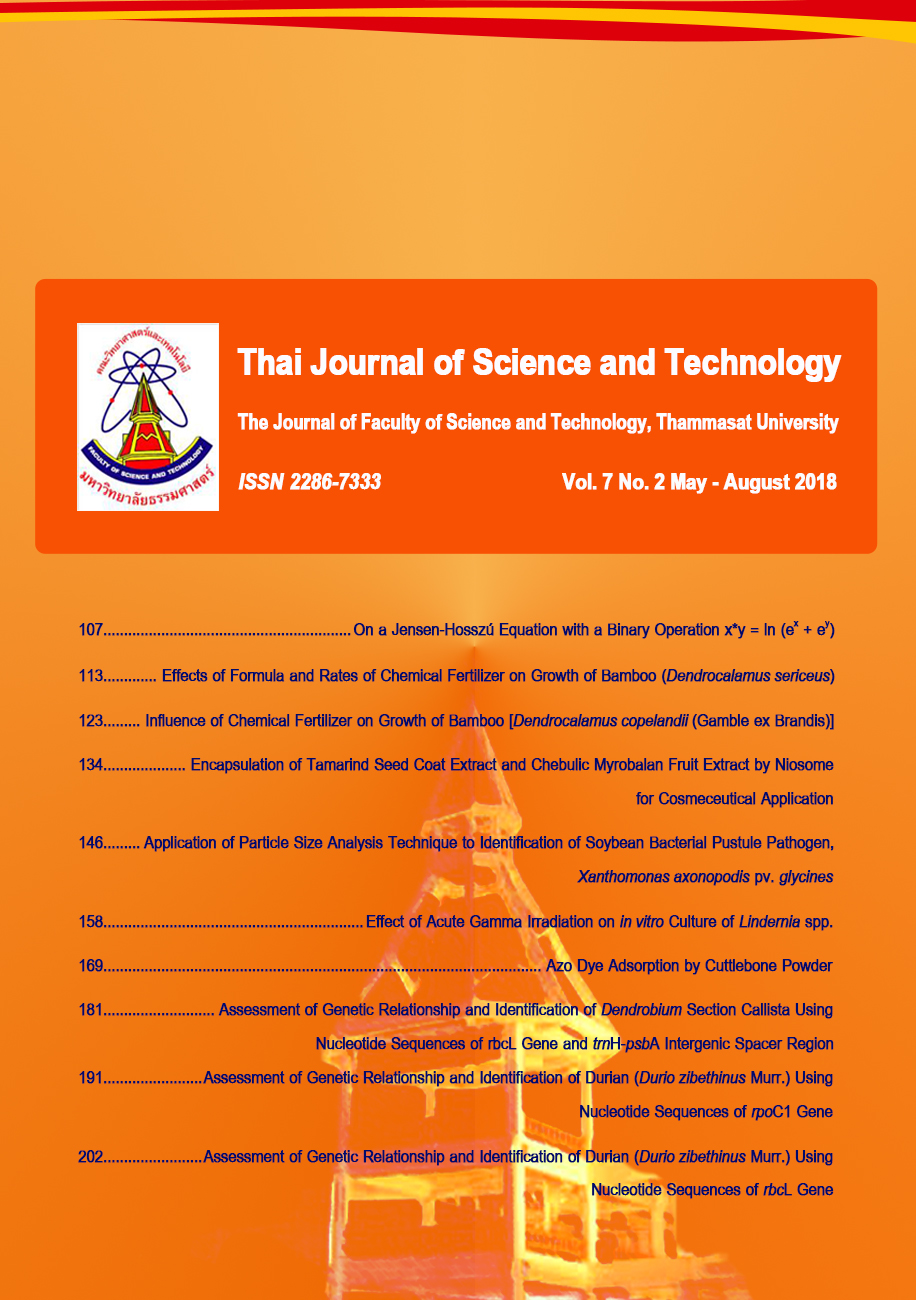การประยุกต์เทคนิควิเคราะห์ขนาดอนุภาคสำหรับจำแนก Xanthomonas axonopodis pv. glycines สาเหตุโรคใบจุดนูนถั่วเหลือง
Main Article Content
Abstract
บทคัดย่อ
การจำแนก Xanthomonas axonopodis pv. glycines สาเหตุโรคใบจุดนูนบนถั่วเหลือง มีการประยุกต์เทคนิคต่าง ๆ เข้าร่วมในการจัดจำแนก ได้แก่ เทคนิคทางสัณฐานวิทยา ความสามารถในการก่อให้เกิดโรค และเทคนิคต่าง ๆ ด้านดีเอ็นเอ ซึ่งการศึกษาวิจัยครั้งนี้เพื่อพัฒนาและประยุกต์เทคนิควิเคราะห์ขนาดอนุภาค ด้วยโปรแกรมวินโดว์ SZ-100 ในการจำแนก X. axonopodis pv. glycines เปรียบเทียบกับแบคทีเรียในจีนัสเดียวกันและต่างจีนัส ประกอบด้วย X. campestris pv. campestris, X. oryzae pv. oryzae, X. oryzae pv. oryzicola, X. axonopodis pv. vesicatoria, X. axonopodis pv. citri, X. axonopodis pv. malvacearum, X. axonopodis pv. manihotis, Pectobacterium carotovorum subsp. carotovorum, Escherichia coli และ Bacillus amyloliquefaciens ผลการวิจัยพบว่าเทคนิควิเคราะห์ขนาดอนุภาคจำแนก X. axonopodis pv. glycines ออกจากแบคทีเรียสายพันธุ์เปรียบเทียบอื่น ๆ ได้แตกต่างทางสถิติ (P = 0.05) โดยความเข้มข้นต่ำสุดที่สามารถใช้การวิเคราะห์ด้วยเทคนิคนี้คือ 2 x 108 cfu/ml หรือ optical density เท่ากับ 0.3 เทคนิคที่ประสบความสำเร็จนี้แสดงผลได้อย่างรวดเร็ว แม่นยำสูง และไม่ต้องใช้สารเคมีอันตราย ซึ่งสามารถนำเข้าร่วมในกระบวนการจำแนกเชื้อสาเหตุโรคใบจุดนูนและแบคทีเรียอื่น ๆ ได้อย่างมีประสิทธิภาพ
คำสำคัญ : ความกว้างเซลล์; ความยาวเซลล์; สัณฐานวิทยา; เครื่องวิเคราะห์ขนาดอนุภาคนาโน
Abstract
Identification of Xanthomonas axonopodis pv. glycines, the causal agent of pustule disease on soybean using several techniques including morphology, pathotype and DNA-based techniques, was performed. This study focused on development and application of particle size analysis technique using windows SZ-100 to identify X. axonopodis pv. glycines compared to other Xanthomonads and other bacteria including X. campestris pv. campestris, X. oryzae pv. oryzae, X. oryzae pv. oryzicola, X. axonopodis pv. vesicatoria, X. axonopodis pv. citri, X. axonopodis pv. malvacearum, X. axonopodis pv. manihotis, Pectobacterium carotovorum subsp. carotovorum, Escherichia coli and Bacillus amyloliquefaciens. Results revealed that particle size analysis technique showed significantly difference between X. axonopodis pv. glycines and others (P = 0.05). The minimum concentration of bacterial suspension that suits for this technique was 2 x 108 cfu/ml or optical density with 0.3. This successful technique showed quick results with high accuracy and did not use dangerous chemicals that could integrate to bacterial pustule pathogen and other bacterial identification.
Keywords: cell width; cell length; cell morphology; nanoparticle analyzer
Article Details
บทความที่ได้รับการตีพิมพ์เป็นลิขสิทธิ์ของคณะวิทยาศาสตร์และเทคโนโลยี มหาวิทยาลัยธรรมศาสตร์ ข้อความที่ปรากฏในแต่ละเรื่องของวารสารเล่มนี้เป็นเพียงความเห็นส่วนตัวของผู้เขียน ไม่มีความเกี่ยวข้องกับคณะวิทยาศาสตร์และเทคโนโลยี หรือคณาจารย์ท่านอื่นในมหาวิทยาลัยธรรมศาสตร์ ผู้เขียนต้องยืนยันว่าความรับผิดชอบต่อทุกข้อความที่นำเสนอไว้ในบทความของตน หากมีข้อผิดพลาดหรือความไม่ถูกต้องใด ๆ
References
จิตติมา โสตถิวิไลพงศ์, วิลาวรรณ์ เชื้อบุญ และดุสิต อธินุวัฒน์, 2558, สารสกัดหยาบพืชควบคุมโรคเน่าเละของผักกาดขาวปลี, Thai J. Sci. Technol. 4(3): 244-254.
ชัยสิทธิ์ ปรีชา, 2531, การแพร่กระจาย ความรุนแรง
และการประเมินความเสียหายเนื่องจากโรคใบจุดนูนของถั่วเหลืองในประเทศไทย, วิทยา นิพนธ์ปริญญาโท, มหาวิทยาลัยเกษตรศาสตร์, กรุงเทพฯ.
นิภาพร ดวงแก้ว, วิลาวรรณ์ เชื้อบุญ และดุสิต อธินุวัฒน์, 2558, แบคทีเรียที่มีประโยชน์ชักนำการสะสมกาบาในเมล็ดข้าวกล้องงอกอินทรีย์, Thai J. Sci. Technol. 4(2): 123-132.
นลินา เหมสนิท, 2554, การใช้เชื้อแบคทีเรียปฏิปักษ์ Pseudomonas fluorescens SP007s ชักนำให้คะน้าเกิดความต้านทานต่อโรคและแมลงศัตรูพืช, วิทยานิพนธ์ปริญญาโท, มหา วิทยาลัยเกษตรศาสตร์, กรุงเทพฯ.
ปาริชาติ สถิตธรรมพนา, วิลาวรรณ์ เชื้อบุญ และดุสิต อธินุวัฒน์, 2555, ประสิทธิภาพแบคทีเรียปฏิปักษ์สายพันธุ์ใหม่ TU-Orga1 ในการส่งเสริมการเจริญเติบโตและควบคุมโรคขอบใบแห้งของข้าว, Thai J. Sci. Technol. 1(3): 180-188.
แสงเดือน สายแสงทอง, 2542, การศึกษาลักษณะ fingerprinting genome ของ Xanthomonas campestris pv. glycines สายพันธุ์ต่าง ๆ โดยวิธี Random Amplified Polymorphic DNA (RAPD), วิทยานิพนธ์ปริญญาโท, มหาวิทยา ลัยเกษตรศาสตร์, กรุงเทพฯ.
Alipour, Y., 2013, A guide for diagnosis detection of quarantine pests, Soybean bacterial pustule Xanthomonas axonopodis pv. glycines (Nakano) Vauterin et al., 1995 Xanthomonadales: Xanthomonadaceae, Ministry of Jihad-e-Agriculture Plant Protection Organization, Iran.
Athinuwat, D., Prathuangwong, S. and Burr, T.J., 2009, Xanthomonas axonopodis pv. glycines soybean cultivar virulence specificity determinate by avrBs3 homolog, avrXag1, Phytopathology 99: 996-1004.
Dye, D.W., 1978, Genus Xanthomonas Dowson 1939, In Young, J.M., Dye, D.W., Bradbury, J.F., Pangopoulos, C.G., Robbs, C.F. (Eds.), 1978, A proposed nomenclature and classification for plant pathogenic bacteria, NZJAR 21: 153-168.
Gautam, S. and Sharma, A., 2003, Xanthomonas program cell death has similarities with eukaryotic apotosis, BARC Newslett. 249: 81-90.
Goto, M., 1992, Citrus canker, In Kumer, J., Chaube, H.S., Singh, U.S., Mukhopadhyay, A.N. (Eds.), Plant Diseases of International Importance, Vol. III, Diseases of Fruit Crops, Prentice Hall, Englewood Cliffs, NJ.
Kotlarchyk, M., Chen, S.H., and Asano, S., 1979, Accuracy of RGD approximation for computing light scattering properties of diffusing and motile bacteria, Appl. Opt. 18: 2470-2479.
Mehrotra, R.S. and Aggarwal, A., 2003, Plant Pathology, 2nd Ed., Tata McGraw-Hill Publishing Company Ltd., New Delhi.
OEPP/EPPO,1988, Data sheets on quarantine organisms No. 157, Xanthomonas campestris pv. vesicatoria, OEPP/EPPO Bull. 18: 521-526.
OEPP/EPPO, 1979, Data sheets on quarantine organisms No. 3, Xanthomonas campestris pv. oryzicola, OEPP/EPPO Bull. 9(2).
OEPP/EPPO, 1980, Data sheets on quarantine organisms No. 2, Xanthomonas campestris pv. oryzae, Bulletin OEPP/EPPO Bulletin
10(1).
OEPP/EPPO, 1990, Specific quarantine requirements, EPPO Technical Documents, No. 1008.
Prathuangwong, S. and Kasem, S., 2004, Screening and evaluation of thermotolerant epiphytic bacteria from soybean leaves for controlling bacterial pustule disease, Thai J. Agr. Sci. 37: 1-8.
Prathuangwong, S. and Khandej, K., 1989, An artificial inoculation method of soybean seed with Xanthomonas campestris pv. glycines for inducing disease expression, Kasetsart J. (Nat. Sci.) 32: 84-89.
Prathuangwong, S., Kasem, S., Thowthampitak, J. and Athinuwat, D., 2005, Multiple plant response to bacterial mediated protection against various diseases, J. ISSAAS 11(3): 79-87.
Prathuangwong, S., Khandej, K. and Goto, M., 1994, Development of new methods for ecological study of soybean bacterial pustule: A semiselective medium for detecting Xanthomonas campestris pv. glycines in contaminated soybean seed, pp. 197-202, Proceedings of World Soybean Research, Chiang Mai.
Reshes, G., Vanounou, S., Fishov I. and Feingold, M., 2008, Cell shape dynamics in Escheri-chia coli, Biophys. J. 94: 251-264.
Rodriguez-R, L.M., Grajales, A., Arrieta-Ortiz, M., Salazar, C., Restrepo, S. and Bernal, A., 2012, Genomes based phylogeny of the genus Xanthomonas, BMC Microbiol. 12: 43.
Sain, S.K. and Gour, H.N., 2013, Pathological
and physio-biochemical characterization of Xanthomonas axonopodis pv. glycines, incitent of Glycine max leaf pustules, Ind. Phytopath. 66: 20-27.
Sambamurty, A.V.S.S., 2006, A Textbook of Plant Pathology, I.K. International Pvt. Ltd., New Delhi.
Schaad, N.W., Jones, J.B., Chun, W., 2001, Laboratory Guide for Identification of Plant Pathogenic Bacteria, 3rd Ed., American Phytopathological Society, St. Paul, Minnesota.
Stull, 1972, Size distribution of bacterial cells, J. Bacteriol. 109: 1301-1303.
Vauterin, L., Hoste, B., Kersters, K. and Swings,
J., 1995, Reclassification of Xanthomonas, Int. J. Syst. Bacteriol. 45: 472-489.
Violatti, M.R. and Tebaldi, N.D., 2016, Detection of Xanthomonas xonopodis pv. glycines in soybean seeds, Summa phytopathol. 42: 268-270.
Wyatt, P.J., 1968, Differential light scattering: A physical method for identifying living bacterial cells, Appl. Opt. 7: 1879-1896.
Wyatt, P.J., 1969, Identification of bacteria by differential light scattering, Nature 221: 1257-1258.
Whitman, W.B., 2009, Bergey’ s Manual of Systematic Bacteriology, 2nd Ed., Springer, Dordrecht Heidelberg, New York.


